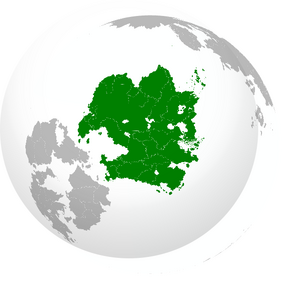Alshar: Difference between revisions
m (Added Alshar navbox.) |
m (→Economy) |
||
| (39 intermediate revisions by 5 users not shown) | |||
| Line 1: | Line 1: | ||
{{NonCanon}} | |||
{{Infobox continent | {{Infobox continent | ||
|title = Alshar | |title = Alshar | ||
| Line 7: | Line 7: | ||
|density = {{convert|25.54|km2|sqmi|abbr=on}} | |density = {{convert|25.54|km2|sqmi|abbr=on}} | ||
|demonym = Alshari | |demonym = Alshari | ||
|countries = | |countries = 14 states | ||
|list_countries = | |list_countries = | ||
|dependencies = | |dependencies = | ||
|unrecognized = | |unrecognized = | ||
|languages = | |languages = {{wp|Daxian}}<br>Kandaran<br>[[Metzi]] | ||
|time = ''TBD'' | |time = ''TBD'' | ||
|internet = | |internet = | ||
}} | }} | ||
'''Alshar''' is a continent located in the Eastern Hemisphere of the globe. | '''Alshar''' is a continent and geographic region located in the Eastern Hemisphere of the globe. Alshar is bound to the south by the [[Pukhthun Sea]], the Sea of Capelan to the north, the Ocean of Cathay to the east and the Audonian landmass and the Levantine Sea to the west. Through millenia of habitation it has been home to many empires and expansive civilizations. It is the second most populated continent and the third largest by total landmass. | ||
== | ==Name== | ||
The continent has several widely used names. The most commonly used, "''Alshar''", descends from the Arabic word الشرق (lit. "''east''", "alshrq"). The term is thought to have originated with [[Occidental]] explorers being sent to the continent east of [[Audonia]], referred to the explorers simply as the "eastern land". | The continent has several widely used names. The most commonly used, "''Alshar''", descends from the Arabic word الشرق (lit. "''east''", "alshrq"). The term is thought to have originated with [[Occidental]] explorers being sent to the continent east of [[Audonia]], referred to by the explorers simply as the "eastern land". | ||
==Extent== | |||
===Regions=== | |||
====Middle seas region==== | |||
The Middle seas region, also known as the Middle seas, or the Audonio-Alshari Intercontinental Cultural and Economic Interface Zone (AAICEIZ, pronounced eye-kayz), is the areas of eastern [[Audonia]] (eastern [[Audonia#Siphost|Siphost]] and [[Audonia#Daria|Daria]]) and western [[Alshar]] around the [[Aab-e-Farus]] and the [[Sea of Kandahar]]. It is so named because of the two seas it contains surrounded by the continental landmasses of [[Audonia]] and [[Alshar]], the [[Aab-e-Farus]] and the [[Sea of Kandahar]]. | |||
===Countries, dependencies, and other territories=== | |||
==History== | ==History== | ||
The Alshari landmass is home to some of the oldest civilizations known to man. | |||
===Natural history=== | |||
==Natural characteristics== | |||
===Geology=== | |||
===Climate=== | |||
===Ecology=== | |||
==Demographics== | |||
===Languages=== | |||
===Religion=== | |||
===Population=== | |||
===Cultural groups=== | |||
====Daxian==== | |||
====Kagoyama==== | |||
====Metzettan==== | |||
====Menzhou==== | |||
==Economy== | |||
[[Category:IXWB]] | [[Category:IXWB]] | ||
Latest revision as of 11:10, 31 August 2023
This article is non-canonical either because it refers to out-of-character content, the associated nations have left the region, or the information has been retconned. Accordingly, its content should not be considered to be part of the canonical structure of the region's lore.
|
 | |
| Area | 61,578,803.73 km2 (23,775,709.04 sq mi) |
|---|---|
| Population | 1,572,893,240 |
| Population density | 25.54 km2 (9.86 sq mi) |
| Demonym | Alshari |
| Countries | 14 states |
| Languages | Daxian Kandaran Metzi |
| Time zones | TBD |
Alshar is a continent and geographic region located in the Eastern Hemisphere of the globe. Alshar is bound to the south by the Pukhthun Sea, the Sea of Capelan to the north, the Ocean of Cathay to the east and the Audonian landmass and the Levantine Sea to the west. Through millenia of habitation it has been home to many empires and expansive civilizations. It is the second most populated continent and the third largest by total landmass.
Name
The continent has several widely used names. The most commonly used, "Alshar", descends from the Arabic word الشرق (lit. "east", "alshrq"). The term is thought to have originated with Occidental explorers being sent to the continent east of Audonia, referred to by the explorers simply as the "eastern land".
Extent
Regions
Middle seas region
The Middle seas region, also known as the Middle seas, or the Audonio-Alshari Intercontinental Cultural and Economic Interface Zone (AAICEIZ, pronounced eye-kayz), is the areas of eastern Audonia (eastern Siphost and Daria) and western Alshar around the Aab-e-Farus and the Sea of Kandahar. It is so named because of the two seas it contains surrounded by the continental landmasses of Audonia and Alshar, the Aab-e-Farus and the Sea of Kandahar.
Countries, dependencies, and other territories
History
The Alshari landmass is home to some of the oldest civilizations known to man.